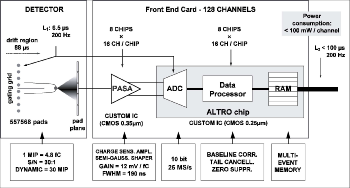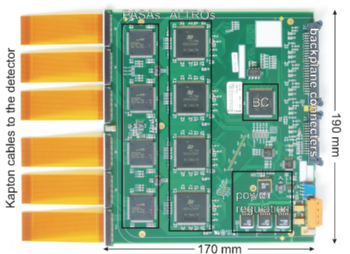
Charged particles traversing the TPC volume ionize the gas along their path, liberating electrons that drift towards the endplate of the chamber. The signal amplification is provided through avalanche effect in the vicinity of the anode wires of the readout chambers. The electrons and positive ions created in the avalanche, which move respectively towards the anode wire and the surrounding electrodes, induce a positive current signal on the pad plane. The current signal of a single avalanche, which is characterized by a fast rise time (less than 1 ns) and a long tail (of the order of 50 microseconds), carries a charge that, in the ALICE TPC, can be as low as a few fC. It is then delivered on the detector impedance which, to a very good approximation, is a pure capacitance of the order of a few pF. The shape of the signal tail, which is due to the motion of the positive ions, is rather complex and depends on the details of the chamber and pad geometry. This tail, causing pile-up effects, sets the main limitation to the maximum track density at which a MWPC can be operated.

The readout of the signal is done by 557568 pads that form the cathode pad plane of the readout chambers. The signals from the pads are passed to 4356 Front-End Cards (FECs), located 7 cm away from the pad plane, via flexible Kapton cables. In the FECs a custom-made charge-sensitive shaping amplifier, named PASA (PreAmplifier ShAper), transforms the charge signal induced in the pads into a differential semi-Gaussian voltage signal that is fed to the input of the ALTRO (ALice Tpc Read Out) chip. Each ALTRO contains 16 channels operating concurrently that digitize and process the input signals. Upon arrival of a first-level trigger, the data stream corresponding to the detector drift time (< 100 mictoseconds) is stored in a memory. When a second-level trigger (accept or reject) is received, the latest event data stream is either frozen in the data memory, until its complete readout takes place, or discarded. The readout can take place at any time at a speed of up to 200 MByte/second through a 40-bit-wide backplane bus linking the FECs to the Readout Control Unit (RCU), which interfaces them to the Data AQuisition (DAQ), the Trigger and the Detector Control System (DCS).
Click here for the homepage of the ALICE TPC Front-End Electronics group.
